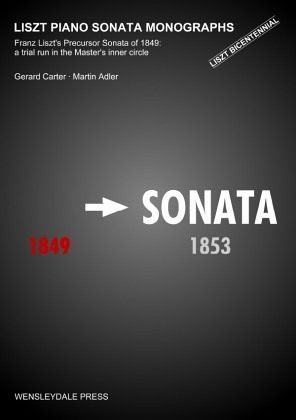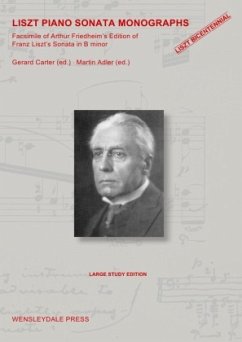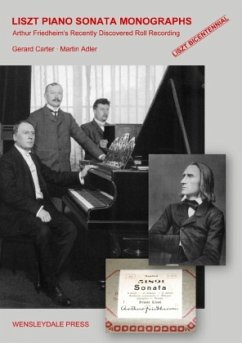
LISZT PIANO SONATA MONOGRAPHS - Franz Liszt's Precursor Sonata of 1849: a trial run in the Master's inner circle
www.lisztsonata.com
Versandkostenfrei!
Versandfertig in 6-10 Tagen
30,00 €
inkl. MwSt.

PAYBACK Punkte
0 °P sammeln!
Franz Liszt completed his Piano Sonata in B minor at Weimar in 1853. It met with a mixed reception from the musical establishment of the day but is now a part of the repertoire of every leading pianist and may even be the most frequently recorded and performed piano work ever written. It is the outstanding example of the compositional process of thematic transformation. The grandeur and lyrical power of its themes, based on three motifs so clearly stated at the outset, place it at the pinnacle of the piano literature.Liszt composed his Sonata in 1852-53, or so we have been led to believe. We n...
Franz Liszt completed his Piano Sonata in B minor at Weimar in 1853. It met with a mixed reception from the musical establishment of the day but is now a part of the repertoire of every leading pianist and may even be the most frequently recorded and performed piano work ever written. It is the outstanding example of the compositional process of thematic transformation. The grandeur and lyrical power of its themes, based on three motifs so clearly stated at the outset, place it at the pinnacle of the piano literature.
Liszt composed his Sonata in 1852-53, or so we have been led to believe. We now know, however that by June 1849 Liszt had already composed a precursor Sonata and tested it by performance to his inner circle. This monograph explains in detail the recently discovered and researched facts obtained by the authors on which this entirely novel proposition is based and places these facts in their historical and musicological context.
Contents:
1818-1848: Influences of Beethoven, Hummel, Schubert, Schumann, Chopin and Alkan
1849 January (est.): Liszt's Sketch of Motifs A and B
1849: Liszt Sketches the Andante sostenuto
1849 January (est.): Liszt Commences Serious Compositional Work on his Sonata
1849 May 30: Liszt Plays "Some New Compositions" for Bülow and Winterberger
1849 May or June: Liszt Tells Bülow that he has "Begun Bigger Works"
1849 May or June (est.): Liszt Plays his Precursor Sonata to his Inner Weimar Circle
1849 July (est.): Kühmstedt Starts to Compose his Fugue Based on Liszt's Motifs B and C
1850 June (est.): Liszt Performs Kühmstedt's Fugue
1850 September: Bülow Plans to Visit Kühmstedt
1853/54: Liszt's Sonata Completed and Published
Liszt's Annotations on the Szendy Copy in Budapest
Liszt's Sonata Compared to Kühmstedt's Fugue
The appendices include all the original sources with translations, comments by Prof. Dr. Tibor Szász and a facsimile of the whole of Kühmstedt's Fugue. A numberof illustrations are included as well as numerous musical examples.
Contact: info@lisztsonata.com
More information: www.lisztsonata.com
Liszt composed his Sonata in 1852-53, or so we have been led to believe. We now know, however that by June 1849 Liszt had already composed a precursor Sonata and tested it by performance to his inner circle. This monograph explains in detail the recently discovered and researched facts obtained by the authors on which this entirely novel proposition is based and places these facts in their historical and musicological context.
Contents:
1818-1848: Influences of Beethoven, Hummel, Schubert, Schumann, Chopin and Alkan
1849 January (est.): Liszt's Sketch of Motifs A and B
1849: Liszt Sketches the Andante sostenuto
1849 January (est.): Liszt Commences Serious Compositional Work on his Sonata
1849 May 30: Liszt Plays "Some New Compositions" for Bülow and Winterberger
1849 May or June: Liszt Tells Bülow that he has "Begun Bigger Works"
1849 May or June (est.): Liszt Plays his Precursor Sonata to his Inner Weimar Circle
1849 July (est.): Kühmstedt Starts to Compose his Fugue Based on Liszt's Motifs B and C
1850 June (est.): Liszt Performs Kühmstedt's Fugue
1850 September: Bülow Plans to Visit Kühmstedt
1853/54: Liszt's Sonata Completed and Published
Liszt's Annotations on the Szendy Copy in Budapest
Liszt's Sonata Compared to Kühmstedt's Fugue
The appendices include all the original sources with translations, comments by Prof. Dr. Tibor Szász and a facsimile of the whole of Kühmstedt's Fugue. A numberof illustrations are included as well as numerous musical examples.
Contact: info@lisztsonata.com
More information: www.lisztsonata.com












